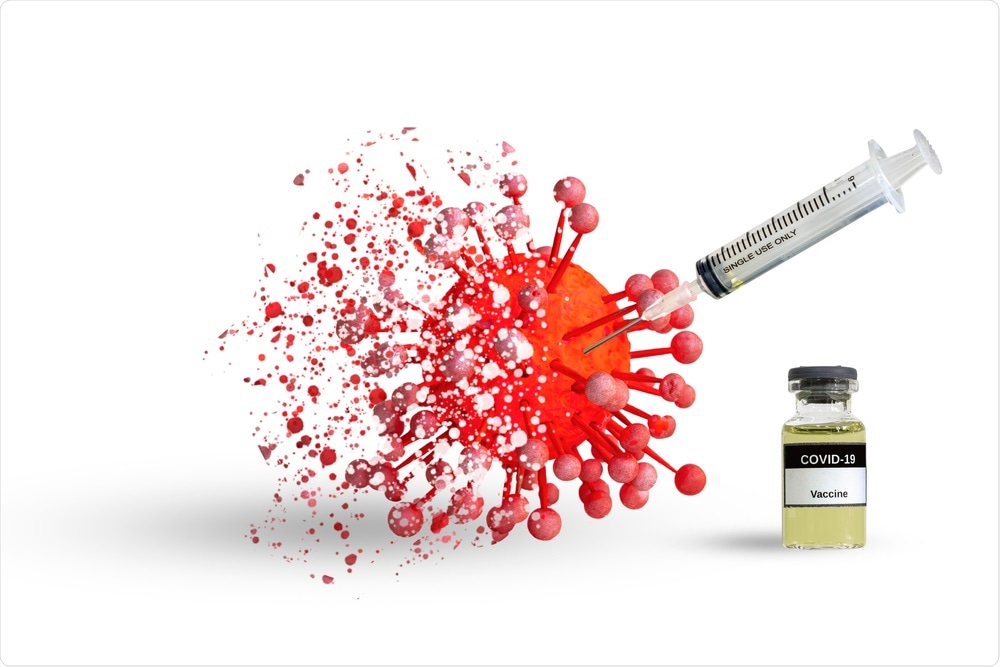The spike (S) protein of the severe acute respiratory syndrome coronavirus 2 (SARS-CoV-2), which is the virus responsible for the coronavirus disease 2019 (COVID-19), consists of two subunits including the S1 and S2 subunits. The S1 bears the receptor-binding domain (RBD), which is responsible for the interaction of the virus with the angiotensin-converting enzyme 2 (ACE2) receptor on the host cell, while the S2 subunit mediates viral fusion.
Currently available SARS-CoV-2 vaccines stimulate the production of neutralizing antibodies against the RBD by either adenovirus vector (AstraZeneca) or the delivery of messenger ribonucleic acid (mRNA) material (Pfizer and Moderna); however, the novel nature of the latter has raised safety concerns. In a paper recently published the preprint server medRxiv*, the authors discuss the results of Phase I clinical trials for two new COVID-19 vaccine candidates based on recombinant RDB proteins, finding them to be safe and immunogenic.
 Study: A randomized, double-blinded phase I clinical of two recombinant dimeric RBD COVID-19 vaccine candidates: safety, reactogenicity, and immunogenicity. Image Credit: Surasak_Photo / Shutterstock.com
Study: A randomized, double-blinded phase I clinical of two recombinant dimeric RBD COVID-19 vaccine candidates: safety, reactogenicity, and immunogenicity. Image Credit: Surasak_Photo / Shutterstock.com
About the study
The two recombinant protein vaccines explored in the current study are termed FINLAY-FR-1 and FINLAY-FR-1A, both of which are adsorbed on an alum adjuvant. Notably, the FINLAY-FR-1 vaccine also bears outer membrane vesicles from Neisseria meningitides, which have been used as an adjuvant in several other vaccines.
Bacterial outer membrane vesicles can also facilitate antigen capture and presentation to T-cells in order to stimulate an immune response. A total of 60 volunteers between the ages of 19-59 with healthy body mass index (BMI) were recruited for the study, either receiving two doses of 25 micrograms (µg) of the FINLAY-FR-1 vaccine, or 25 µg or 50 µg of FINLAY-FR-1A. The participants also received a third dose in either a heterologous or homologous regime.
Background anti-SARS-CoV-2 antibodies were determined for each participant by enzyme-linked immunosorbent assay (ELISA) and virus neutralization assays immediately before vaccination. Blood samples were also collected at the times of second and third vaccinations, and 28 days after the third dose. Active observations were performed on each participant on days 1, 2, 3, and 7 following dosing, and each participant was also asked to keep a diary to report any adverse events.
Efficacy and safety of recombinant protein vaccines
The first dose of any of the vaccines was seen to elicit very little anti-SARS-CoV-2 RBD antibody production, with seroconversion rising to 100%, 94.7%, and 94.4% after the third dose for FINLAY-FR-1, FINLAY-FR-1A (25 µg), and FINLAY-FR-1A (50 µg), respectively.
As compared to controls composed of convalescent sera collected from asymptomatic individuals, the vaccines induced greater inhibition of RBD -ACE2 interaction. Additionally, neutralizing antibody titers exceeded those in sera in all cases for those receiving homologous dosing of FINLAY-FR-1, and for 90% of participants under a heterologous regimen.
Live-virus neutralizing antibodies were detected after the second dose in 85% of those receiving the FINLAY-FR-1 vaccine, rising to 100% after the third dose. A lesser response was observed from the FINLAY-FR-1A vaccine at the lower dose, with 94.7% of participants exhibiting live-virus neutralizing antibodies.
The live-virus neutralization capacity reported by these vaccines exceeds that reported by several inactivated virus vaccines and some adenovirus vector vaccines. Notably, this capacity is lower than that which has been reported by current mRNA COVID-19 vaccines.
The authors suggest that initial exposure to the vaccine is able to stimulate naïve lymphocytes. Subsequent re-exposure induces a secondary immune response in a rapid manner, generating a large increase in anti-RBD neutralizing antibodies. A third dose was seen to improve the effect further with few adverse effects. Taken together, these vaccines are also currently in the clinical trial stage as boosters for individuals who have already received another type of vaccine.
The FINLAY-FR-1 vaccine containing the Neisseria meningitides outer membrane vesicles was better able to stimulate an immune response in participants, though more adverse events were reported.
Approximately 80% of all participants reported adverse events of some type during the study, most of which were mild and local, lasting less than 24 hours. Four events that were considered severe occurred during the course of the study, constituting pain and localized swelling.
Participants receiving FINLAY-FR-1 reported more adverse events than those receiving any size dose of FINLAY-FR-1A, possibly due to the inclusion of bacterial outer membrane vesicles as an adjuvant. Importantly, however, a lower proportion of adverse events reported for FINLAY-FR-1 were considered as vaccine-derived, with most of the additional events reported as “general malaise.”
Overall, the difference in reported adverse events was not statistically significant between groups, and comparable to other COVID-19 vaccines currently available.
*Important notice
medRxiv publishes preliminary scientific reports that are not peer-reviewed and, therefore, should not be regarded as conclusive, guide clinical practice/health-related behavior, or treated as established information.
- Perez-Rodriguez, S., de la Rodriguez-Gonzalez, M., Ochoa-Azze, R., et al. (2021). A randomized, double-blinded phase I clinical of two recombinant dimeric RBD COVID-19 vaccine candidates: safety, reactogenicity and immunogenicity. medRxiv. doi:10.1101/2021.10.04.21262522. https://www.medrxiv.org/content/10.1101/2021.10.04.21264522v1
Posted in: Drug Trial News | Medical Science News | Medical Research News | Disease/Infection News
Tags: ACE2, Adenovirus, Angiotensin, Angiotensin-Converting Enzyme 2, Antibodies, Antibody, Antigen, Assay, Blood, Body Mass Index, Cell, Clinical Trial, Coronavirus, Coronavirus Disease COVID-19, Efficacy, Enzyme, Homologous, Immune Response, Membrane, Pain, Protein, Receptor, Respiratory, Ribonucleic Acid, SARS, SARS-CoV-2, Severe Acute Respiratory, Severe Acute Respiratory Syndrome, Syndrome, Vaccine, Virus

Written by
Michael Greenwood
Michael graduated from Manchester Metropolitan University with a B.Sc. in Chemistry in 2014, where he majored in organic, inorganic, physical and analytical chemistry. He is currently completing a Ph.D. on the design and production of gold nanoparticles able to act as multimodal anticancer agents, being both drug delivery platforms and radiation dose enhancers.
Source: Read Full Article
